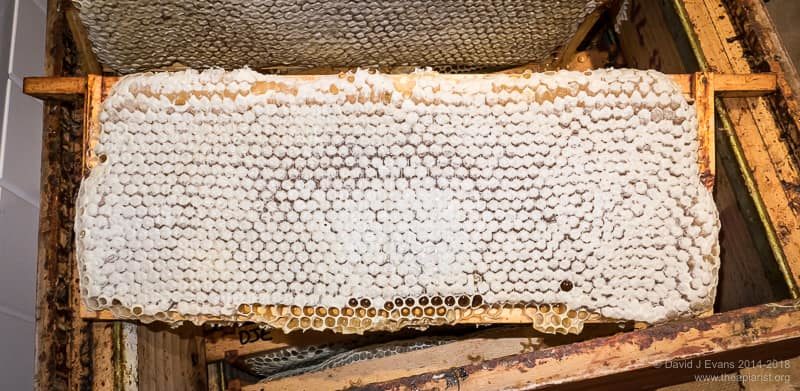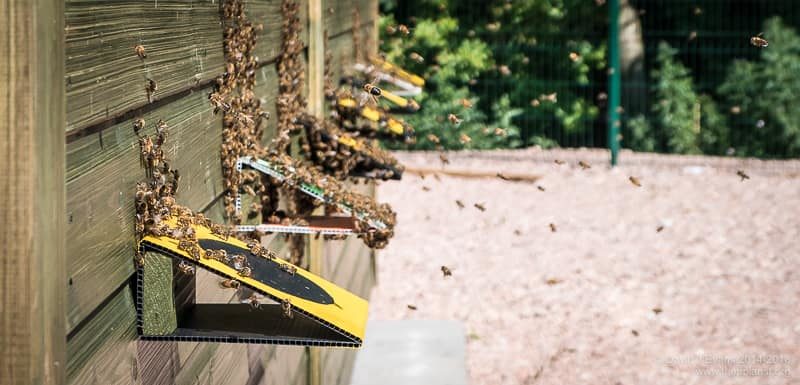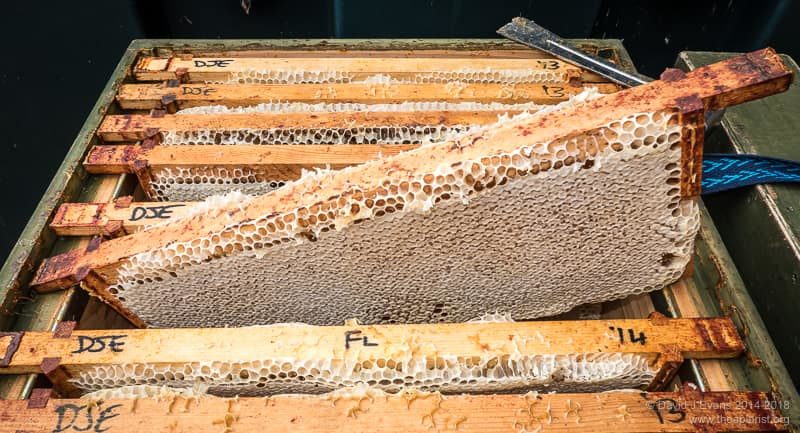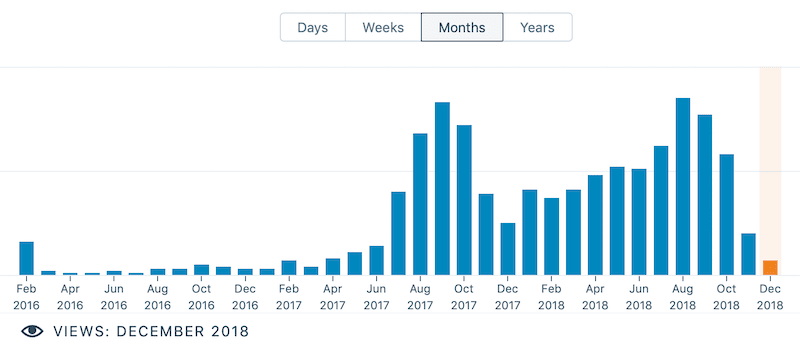2018 in retrospect
How was 2018 for you?
It was a good year here in Fife, with more of everything; more snow, more colonies, more honey (much more honey ? ), more sheds, more wasps, more swarms and more dead Varroa.
Actually, the ‘more dead mites’ isn’t quite correct but I’ll return to that later.
The Beast from the East
There’s not much to say about the winter, but as we moved from February into March Storm Emma (also called the Beast from the East) arrived. The wind whipped the snow across the Howe of Fife (the largely flat centre of the county), dumping large drifts whenever it eddied over hedges or buildings. I had to dig us out of the house and the road from the village was impassable for 2-3 days.
The colonies were all snug, if not warm, and weathered the storm without mishap. The reality is that if colonies are properly prepared for winter there’s almost nothing to do – or nothing you can do – until the weather picks up again in the Spring.
During the early part of the year I finished preparing our new bee shed. The bees were installed at the very end of March, soon followed by installation of a solar lighting system.
As I write this (early December 2018) the old apiary site has recently been bulldozed flat to make way for a new road. The contractors felled most of the beautiful trees in the well-established arboretum that surrounded the apiary.
All that’s left now is a muddy, ugly scar across the landscape waiting to be tarmac’d. Every time I drive past the line from The Last Resort by The Eagles, “Some rich men come and raped the land”, comes to mind.
That’s progress ?
On a slightly brighter note, we did save the original shed and it’s recently been reassembled on the new apiary site. This will provide some much needed storage space. The new shed is bigger, but still a bit cramped when used for storage, work and bees.
In like a lion, out like a lamb
Well, almost. March continued cold but the weather had picked up by mid-April. I’d lost just two colonies in the winter, both due to failed queens. By the third week of April I’d started inspections {{1}} and colonies were all looking pretty good.
The weather got better and better, the oil seed rape (OSR) flowered and the bees started hammering it. Only one of my apiaries had OSR in range and they did really well.
By the middle of June the OSR was over and the honey was all extracted. The high glucose content of OSR nectar means it crystallises fast and very hard. It needs to be extracted before this happens in the frames. Some find OSR honey rather bland or an acquired taste. However, I’ve just processed the first couple of buckets into soft set honey and it’s excellent on toast.
The June gap
In terms of beekeeping it was non-stop. June was frantically busy. Even before the the Spring honey was off the crowded colonies had started to make preparations for swarming.
Just as the bees were preparing to move house I was also busy moving into a new house. It was manic. As fast as I put split boards into colonies more queen cells would appear. I started to run out of frames and brood boxes. I managed to hold some colonies back by slicing out great slabs of drone comb. This takes just a few seconds using foundationless frames and gives the bees something to do rather than make swarm preparations.
And in between all this I was interminably packing, driving and unpacking rental vans doing my own move.
I know I lost a couple of swarms – from about 20 colonies in total {{2}} – which left me feeling a bit guilty. At least they left with very low Varroa levels so, for a time at least, they would not contribute to the mite levels in the local environment. To ‘compensate’ for colonies that might establish themselves somewhere unwanted I donned my beesuit and destroyed a huge wasps nest in a neighbours roof space.
I also gratefully received a good-sized swarm in a bait hive.
The ‘June gap’ refers to the dearth of nectar that often occurs at this time of year. This year – despite excellent weather – was no exception. I didn’t feed colonies but many around me did. A few were a bit light but were OK until the summer flow started … which it did in late June or early July.
The flow must go on
Lime, blackberry, clover, rosebay willow herb and goodness knows what else. It was excellent. Coupled with continued good weather, hives got taller and taller as more supers were added. I ran out of supers altogether.
With lots of nectar and great weather for inspections it was my best beekeeping year since I moved back to Scotland.
The good weather also aided queen mating which helped with requeening and preparing nucs for overwintering. About 75% of my colonies were requeened this year, almost all through splits of one type of another.
And then it was all over
The flow eventually stopped and the extraction was interminable. Not that I’m complaining. Super after super after super looked like this:
Wasps were a big problem in late summer. I lost a queenless colony and a nuc to the stripey blighters. Amazingly I managed to save the queen from the nuc {{3}} and she’s now heading a strong colony through the winter.
After a fortnight or so tidying, stock-taking (uniting colonies, cleaning cleared supers, making up a few additional nucs) and ‘final’ inspections it was time to start Varroa treatment and feeding colonies up for winter.
I’ve deliberately finished the season with fewer colonies than I started, but with more overwintering nucleus colonies for sale or making up losses. The absence of a work/life balance means I want to reduce my personal colony numbers by about a third for the next couple of years (to ~10), with another 6-8 overwintering for work. I’ll still be busy ?
Mite news
Mite levels have been extraordinarily low this season. For work we uncapped many hundreds to low thousands of individual pupae {{4}} and found no more than half a dozen mites all season. We’ve seen no evidence of DWV symptoms and irregular mite counts on the Varroa trays have yielded very low numbers.
All colonies were treated by sublimation with an oxalic acid-containing treatment in early September, with three applications at five day intervals. The mite drop was so low (<200 from eight colonies in total in one apiary) that I was concerned that the treatment had failed. I therefore followed it up with Apivar strips in half the colonies. One or two additional dead mites appeared, but that was all.
So, not more dead Varroa, but probably a much greater proportion of the mite population were killed.
The Apiarist in 2018
This is the 300th post over the last five years. Yes, I’m surprised as well. I missed only one Friday when my hosting service was either not hosting or not providing a service ?
A few weeks ago I moved the site to a cloud-based virtual server (Amazon LightSail) which, to me at least {{5}} appears faster and more stable. Processor load is 10% what it was and page response times seem much better. Tell me if it isn’t.
Unique visitor numbers and page reads continue to increase year on year with both up ~33% on last year. What is particularly reassuring is that articles I’ve written on disease management now feature as the most read over the course of the year (though several were written in previous years). The ‘top five’ are:
- When to treat? – the importance of correctly timing the early autumn Varroa treatment.
- Feeding fondant – quicker, easier and possibly better for the bees.
- Oxalic acid preparation – making Api-Bioxal solution properly for trickle treating.
- Vertical splits and making increase – manipulations for swarm control and expansion.
- Making soft set honey – making all that OSR honey look good and sell well.
The composite page on ‘Equipment‘ also featured amongst this top five, but takes visitors off to all sorts of articles on bee sheds, DIY and hive reviews.
And the future …
This post is already too long. I’ve just checked and see I have 55 posts with working titles and scrawled notes in my drafts folder {{6}}. That suggests there’s likely to be something written next year.
Until then … Happy New Year
{{1}}: A full three weeks earlier than I’d managed for some colonies in 2017.
{{2}}: Only about 8 of these were honey production colonies. The remainder were for work or were being built up for splitting and nuc production.
{{3}}: I found her barricaded in the corner of the nuc with about a hundred harassed workers after I tried all the usual tricks of sealing the entrance and moving them to a new apiary.
{{4}}: Individually, not dozens at a time with an uncapping fork! Every one was inspected as was the emptied cell. We need the pupae for experiments in the laboratory.
{{5}}: And I’ve not received any comments or complaints.
{{6}}: Though disappointingly there are more titles than notes, implying I’ve still got some work to do.





Join the discussion ...